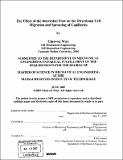The effect of the interstitial flow on the directional cell migration and sprouting of capillaries
Author(s)
Wan, Chen-rei
DownloadFull printable version (12.33Mb)
Other Contributors
Massachusetts Institute of Technology. Dept. of Mechanical Engineering.
Advisor
Roger Kamm.
Terms of use
Metadata
Show full item recordAbstract
Development of functional endothelium in tissue engineering is both critical and challenging. It is critical because of its role in transporting nutrient and waste in tissues larger than the length scale of diffusion. It is challenging because of its complexity in both the chemical and mechanical environments actively evolving in both space and time. In addition to the signals from the microenvironment, cells are more than likely to receive global signaling as well. The goal of the overall project is to establish a functional endothelium for a long period of time under the optimal chemical and physical conditions. This master's thesis project focuses specifically on the effect of interstitial fluid flow on the capillary morphogenesis process. Interstitial fluid flow is defined as flow perpendicular to the endothelial monolayer, as opposed to shear flow which is parallel. Interstitial flow is an essential process in vivo both in normal physiology and pathology. Liver filtration system, angiogenesis during wound healing, vasculogenesis during fetal development and lymphoangiogenesis are a few examples that depend heavily on interstitial flow. Pathologically, interstitial flow is observed when the vessels are abnormally leaky, such as the case in tumor-induced angiogenesis. (cont.) In vivo observations of angiogenesis suggest the nascent blood vessels sprout from the venous end. This indicates that the interstitial flow direction is opposite of the direction of sprouting. In vitro studies of interstitial flow on endothelial cells are not done until the recent development of three dimensional culture systems. The studies suggest that capillary branching is biased the direction of interstitial flow when VEGF is matrix-bound. The seemingly contradicting results ignite our interest in investigating whether the direction of interstitial flow has an impact on the directional migration or sprouting of endothelial cells or not in a device-independent method in vitro. Two different designs of 3D culture bioreactors were used, one in the millimeter scale while the other one in micrometer scale. In the meso-scale bioreactor, the endothelial cells appeared to migrate and sprout against the flow direction. This result is consistent whether cells were seeded as a monolayer or suspended in collagen gel. This finding seemed to be opposite from the current in vitro findings in the literature. Therefore, another device was used to examine the same problem in attempt to eliminate the artifacts of a certain device. (cont.) In the microfluidic device, no consistent correlation was found between the direction of flow and the extent of cell migration and capillary morphogenesis. Extension gel contraction was observed which made the analysis more difficult and the assumption of interstitial flow through the collagen gel in the device less valid. Multiple endothelial cell monolayers were observed migrating on the gel surface and the 3D reconstruction images suggest possible connections between the monolayer forming complex 3D networks. This project examined the two three-dimensional culture systems allowing endothelial cell invasion and migration. Although the results didn't align for the two devices, it raised an interesting question of the device-dependency when studying capillary morphogenesis. The different scales can create a different chemical and mechanical environment which changes the relative importance between diffusion and convection. From first-order modeling, it can be seen that the presence of interstitial flow can have a drastic influence on the endogenous concentration of chemicals although the corresponding cell migration behavior was not observed experimentally. (cont.) Therefore, the definitive answer of the effect of interstitial flow on capillary morphogenesis is still open to debate. To truly investigate the effect of interstitial flow on the directional cell migration and sprouting, more attention needs to be paid toward understanding the relative importance of diffusion and migration in the specific experimental setup.
Description
Thesis (S.M.)--Massachusetts Institute of Technology, Dept. of Mechanical Engineering, 2007. Includes bibliographical references (p. 89-92).
Date issued
2007Department
Massachusetts Institute of Technology. Department of Mechanical EngineeringPublisher
Massachusetts Institute of Technology
Keywords
Mechanical Engineering.